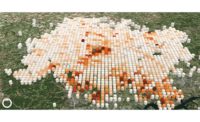Tasha King-Davis, environmental compliance and permits head at the Memphis, Tenn., division of public works, has become a believer—an evangelical even—in the power of data.
As the administrator of the nation’s 14th-largest industrial wastewater discharge monitoring system, she and her staff of 13 can only physically sample the discharges from each of Memphis’ 104 industrial sites about twice a year.
But a year ago, Brown and Caldwell started installing sensors on the outfalls of some of those plants and now, King-Davis can check what those plants are putting into the wastewater stream 24 hours a day, seven days a week—from her phone. She can even set up alerts through Microsoft Power BI so she’s notified if any of them exceed permissible limits.
“It’s an amazing tool that I wish we knew about years ago,” she says. “You can’t hire enough people to go to 104 industries and pull that data continuously every day. The fact that we can use tech, use data and actually help improve our department and become best in the industry—that means a lot to me. It’s my passion.” The pilot test in Memphis is just one small example of the potential of “digital water” or the “internet of water” that is gaining acceptance in an industry that has historically been slow to embrace change.
Earlier this year, Arcadis and Bluefield Research released a report that found the use of predictive analytics and artificial intelligence could save water, wastewater and stormwater utilities $17.6 billion through 2027.
“You see smart technology everywhere,” says Jim Cooper, intelligent water lead for Arcadis. “I think we are in this transition phase for the water sector. We’ve collected the data and we have the communication technology, but we are not fully leveraging technology.”
Data is being used to do things such as plan new water plants and systems, detect leaks, notify customers of outages, predict needed maintenance, extend the life of infrastructure, and better manage and minimize the use of energy and chemicals in treatment. It’s also being leveraged to prepare for and predict unusual rainfall and flooding events to help make communities more resilient.
But in most places, the data long collected by supervisory control and data acquisition systems, or SCADA, has yet to be put to extensive use. While 79% of water utilities have fully implemented SCADA, only 30% are using mobile-based applications and even fewer—17%—are using cloud-based applications to run operations, according to the American Water Works Association’s 2018 State of the Water Industry report.
Companies like Brown and Caldwell, Arcadis, Bentley Systems and Black & Veatch are making a big push to show how powerful data can be. In its report about the money-saving potential in advanced water systems technologies, Arcadis highlights how real-time information on levels, flow and storage capacity during wet weather events has allowed Cincinnati to cut its expected costs to 1¢ per gallon, from $1.40 per gallon, for stormwater storage and treatment. Using hydraulic modeling, Grand Rapids, Mich., reduced a planned capital investment to $30 million from $1 billion.
Inertia Rules
Many see technology upgrades as yet another demand on their budgets and time and are reluctant to act.
“It’s inertia,” says Tom Walski, senior product manager for Bentley Systems. “We’ve talked to a lot of people, both in engineering and operations, and there’s still a lot of the attitude of ‘if it ain’t broke, don’t fix it.’ ” Even after making it clear that they would get a payback in a few years, many systems just don’t have the money. “They’re just too busy fixing pipe leaks or unclogging blocked sewers to worry about the latest technology,” he says.
Another hesitation is the result of bad experiences with previous runs at technology. “Historically we have had some challenges having confidence in instruments and sensors giving us consistent, reliable data,” says Cindy Wallis-Lage, president of Black & Veatch’s global water business. “We weren’t able to get key data in real time, and we weren’t always able to get all of the data we wanted. Sometimes we were operating on five-day-old data.”
“The fact that we can use tech, use data and actually help improve our department … that means a lot to me.”
– Tasha King-Davis, Administrator of Environmental Compliance and Permits, Memphis Div. of Public Works
That has changed, she says, but brought with it additional challenges that also stymie utilities. “So now you have information overload, and you have to figure out how to integrate that all together,” she says.
While Wallis-Lage and others in the industry advance terms like digital water, smart water and the internet of water, the move to using more data in water systems doesn’t mean a wholesale switch from being analog one minute to being digital the next. The extent of change is entirely dependent on the specific system, says Bentley’s Walski. “One utility may be very advanced in the way they do asset management, but be very behind in the way they integrate their SCADA data into modeling. And the next-door neighbor may be just the opposite,” he says.
The switch to using more data is evolutionary, Walski says.
“I mean digital water probably started in the 1950s” with telemetry, and then SCADA in the 1960s. About 15 years ago, software began importing and analyzing SCADA data, Walski says. About five years ago, the analytics became capable of giving a true picture of what’s going on with water and wastewater systems, says Andrew Chastain-Howley, director of water solutions for Atonix Digital, a subsidiary of Black and Veatch.
Sensors are getting cheaper, more accurate and are able to detect a greater number of inputs. “Sensors are changing all the time, and we can collect a new suite of information,” says Bob Joseph, director of planning and programming for the U.S. Geological Survey’s water resources mission. The mission has more than 8,600 stream flow monitors throughout the nation, and additional sensors for groundwater and other spots where water flows. Most monitors report at 15-minute intervals, giving utilities and emergency managers early warning of events like spills or flash flooding.
Sensors can now even test for E. coli and other bacteria within two to 10 hours. The same test in a lab can take a few days, says John Abrera, smart utility applications lead for Brown and Caldwell, which is working with the Memphis utility.
More than 5,400 sensors and other instruments will be used in the operation of the $1.76-billion, 320-million-gallon-per-day Northeast Water Purification Plant Expansion in Houston, which is being built by a joint venture of Jacobs and CDM Smith (ENR 5/27 p. 34). The instruments will measure the condition of the raw water coming in and quality improvements as the water moves through the plant, says Randy Rogers, the plant’s engineering manager. Without those sensors and the automated processes built into the plant, it might have been impossible to treat the Lake Houston water, which is at the end of a watershed and flushes out up to 12 times a day. “It’s not quite artificial intelligence,” Rogers says, “but call me in five years.”
Predictive Analytics
To help utilities incorporate more data, Brown and Caldwell recommends a three-phased approach. The first phase is to assess what data is already collected and available and improve upon it. The second phase is to use analytics and dashboard technology, such as Microsoft Power BI or Tableau, to integrate and visualize the data. The third phase is to apply machine learning for predictive and prescriptive analytics.
Predictive and prescriptive analytics is where the rubber meets the road for intelligent water, according to Arcadis. It’s those analytics that could save water utilities as much as $17.6 billion in the near term.
“Utilities can optimize their approaches by moving away from relying on industry standard data to algorithms using utility-specific data, which doesn’t need to be perfect to continuously learn and improve asset decisions. Algorithms trained on large historical asset failure datasets and data on individual assets can calculate both the likelihood and the cost of failure,” according to the Arcadis report. Algorithms based on historical maintenance and real-time operational data likewise can help operators make maintenance, rehabilitation and replacement decisions.
By using analytics to prioritize repairs, Kansas City, for example, was able to reduce its maintenance costs by $60,000 over three months, Black & Veatch’s Wallis-Lage says.
“We’ve collected the data and we have the communication technology, but we are not fully leveraging technology.”
– Jim Cooper, Intelligent Water Lead For Arcadis
Advanced analytics and advanced metering infrastructure, or AMI, can use pressure data from a SCADA system to alert operators to potential leaks within about three minutes. Each year, U.S. utilities lose nearly 2 trillion gallons of water—or 15% of the total drinking water nationwide—because of leaks, according to AWWA. In some cities, including Griffin, Ga., Wilmington, Del., and Philadelphia, those losses reach or exceed 40%.
Monaca, Pa., reduced the water leaking from its distribution system to 15% from 50% after installing AMI, which allows two-way communication between a utility and meters and other parts of a water system, according to a report by the Berkeley National Lab.
“We can’t afford to waste anything,” says Wallis-Lage. “We can’t afford to have leaking pipes. The revenue that we should be getting from that water, we can’t afford to waste.”
Walski says one of the best uses of that data is through the creation of a digital twin. In the water sector, digital twins are models based on real-time data. The models behave like the real system as much as possible. “So if you have a pipe break, you want to analyze what we can do today to better address this problem in terms of routing water around that pipe break,” Walski says.
In Lisbon, Portugal, which has seen increasing flooding in the last decade, Bentley Systems helped create a digital twin for urban flood simulations. The model lets the city test alternative scenarios and create a master drainage plan. And in Porto, Portugal, Bentley also helped the local water utility create an online platform that incorporates GIS, real-time network sensors, household meters, SCADA, laboratory billing, work orders and logistics to create a digital twin of the city’s water supply, wastewater, stormwater and bathing water systems. With the twin, the city can forecast flooding and water quality issues, predict system performance, identify failures and be proactive on maintenance.
“They are able to predict, based on the storms coming in, where the flooding is, where and when it’s going to hit and how deep it’s going to be,” Walski says. “We have some really impressive results to help people evacuate or take special measures to minimize the impact of flooding. And with climate change, flooding is probably going to get worse, so it’s becoming more and more important to be able to do those kinds of predictions.”
After that data is collected, cataloged and connected, the final piece of the puzzle is communicating the data, says Wallis-Lage, and not just within a system, but to other agencies and the public.
She says being able to show on dashboards how the utility is reducing water use and saving money helps secure financing for future projects and convince the public of a system’s benefits. “Then we can have the customer working with us,” to reduce water usage and better understand the water system.
GeoDecisions, a division of Gannett Fleming, enables two-way communication with customers through a system called Notify, which uses ESRI’s ArcGIS Online and Portal for ArcGIS to alert customers of everything from outages, to a spike in usage, to overdue bills. “It gives utilities the ability to save a good amount of money over time,” says Brian Smith, vice president of GeoDecisions. “Those are the short-term, very achievable, low-hanging fruit” enabled by data and technology, he says.
The possibilities for “digital water” will only increase when 5G networks come fully online. “5G is critical—directly communicating data that is needed—all the while maybe sending that info up to the cloud that allows long-term analytics,” Smith says.
In addition to resistance to change in the sector, there are other barriers to transitioning to digital. “We spend a lot of our time on interoperability—being able to share data from one system to the next. It’s tough because the data itself changes from year to year—every time you build links between different systems and the formats,” Walski says.
Caution and Potential
Cybersecurity is another concern as the water sector becomes more dependent on computer systems and digital information.
“How can we make our systems smarter but also safer? More connected devices make for smarter systems, but also create points for hackers to monitor, access, or disable critical infrastructure,” says Atonix Digital’s Chastain-Howley. “How utilities manage and safeguard both customer data and behind-the-fence data transport is crucial. We work continuously with our clients to address these concerns.”
“We can’t afford to waste anything. We can’t afford to have leaking pipes.”
– Cindy Wallis-Lage, President of Black & Veatch’s Global Water Business
The sector has suffered a range of attacks, including ransomware, tampering with industrial control systems, manipulation of valve and flow operations and chemical treatment formulas, according to AWWA. Last year, the U.S. Department of Homeland Security and the Federal Bureau of Investigation warned that the Russian government was targeting the water sector and other critical infrastructure.
“The reality of today’s environment is that there is no 100% safe and secure system in the world,” says Luis Casado, the director of Gannett Fleming’s water division. “It’s a reality that drives us to continually work for more stringent security while adhering to industry standards for security provisions and practices.” He says Gannett Fleming’s Notify program, for example, has additional authorization, and access controls are split. They only access, not own, the customer’s personal data.
But even without perfect data, there’s a great deal of promise in the use of data in the water sector, says Bentley’s Walski.
“There is a lot of potential and it’s a matter of making a commitment to do it and taking advantage of that potential,” he says. “We’ve got the tools in our software that can really help people, if they fully utilize them.”










Post a comment to this article
Report Abusive Comment